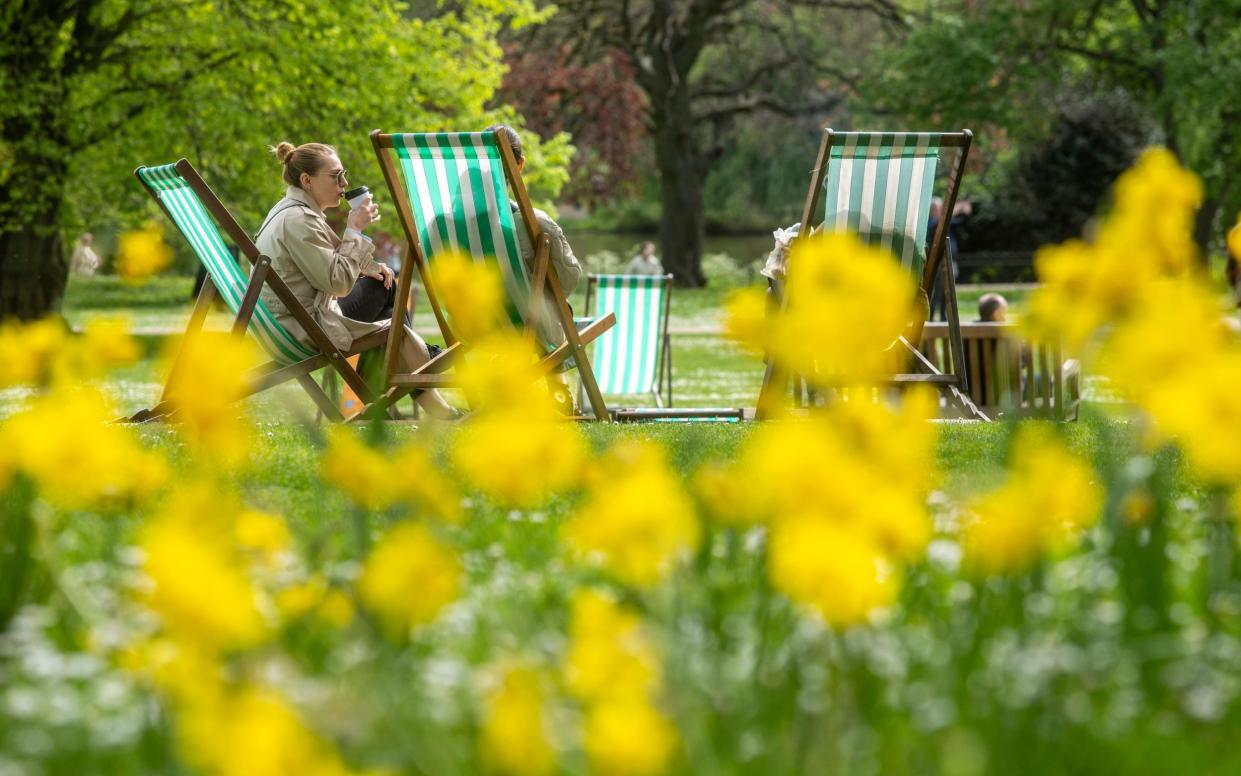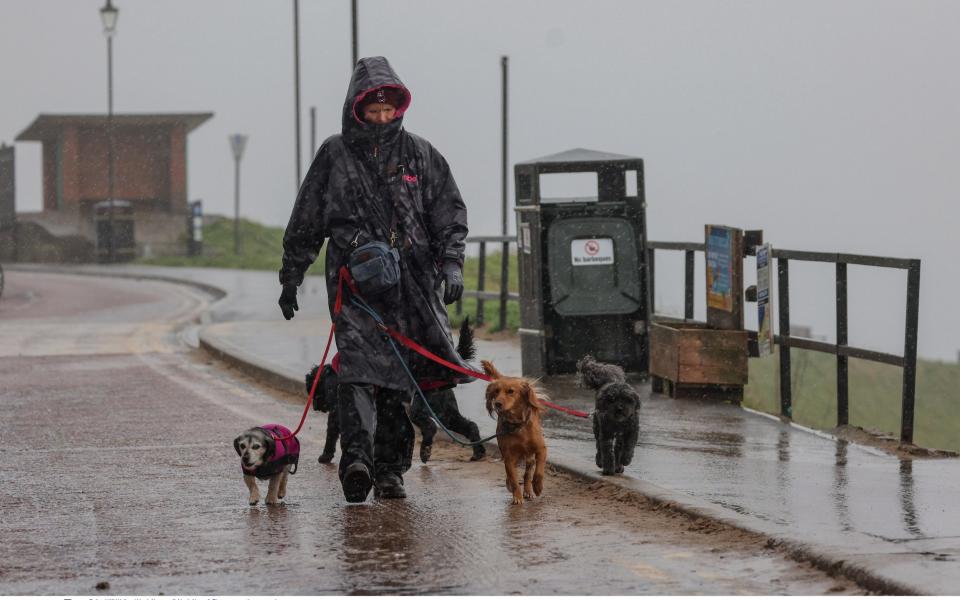Has the weather actually been as freezing as we think this April?

To commuters, at least, it’s always most noticeable first thing in the morning. Passing people on the pavement this month, every individual walking the other way looks dressed for entirely different seasons.
Just this morning, for instance, one brave man in central London passed me in his shirtsleeves, gleefully eating a white chocolate Magnum ice cream for breakfast. Behind him, an aghast woman shuffled along in a down jacket, balaclava and Ugg boots.
Like the meteorological equivalent of dressing for the job you want, Magnum man’s optimism was commendable, because at this point in the sodden, frigid spring of 2024, many of us would try anything to will the mercury up and over even 15C – or anything remotely springlike.
But if it has felt unseasonably cold all month, dominating conversation and causing havoc with your planned transition to a spring-summer wardrobe, how about this for a riddle: the first half of April has, in fact, been warmer than the UK average.
According to the Central England Temperature, the longest-running series of monthly temperature observations in existence, the maximum UK temperature has been 2.5C above the April average (11-16C across the UK), while the overnight temperature has been 3.6C above.
You could be forgiven for having missed them, but there have been bright and warm days this year: the village of Writtle in Essex hit 21.8C on April 13; even Achfary, a hamlet on the shore of Loch nan Ealachan in the Scottish Highlands, reached 19.9C at the end of January.
But those now feel like anomalies. The British public, which has unwritten rules about how weather is discussed, needs a little consistency in order to build a collective memory of how the conditions have been. And whatever the statistics say, the only constant this spring has been cloud, drizzle and a distinct absence of sunshine. To TS Eliot, April was the cruellest month. To update that using modern parlance: April, what an absolute troll.
“The rain in recent weeks hasn’t been especially heavy, it’s just always been there,” says Alex Burkill, a meteorologist at the Met Office. “From most people’s perspectives it’s also been a little disappointing in terms of sunshine: we’ve only had around 42 per cent of the average spring sunshine at this point. The average would be around 59 per cent, so to have had only two-thirds of sunshine is interesting.”
This may not count as breaking news, but after a long, dark winter, it’s sunshine – or the lack of it – that we notice most in spring. “Yes, especially at this time of year, when the sun is getting stronger and stronger, it makes all the difference,” Burkill says.
This spring has been cloudier than usual. “A lot of cloud cover has taken away from the warm spring sunny days. At the moment if it’s cloudy it feels chilly, as the sun isn’t getting through.”
Subjective as it sounds, the Met Office does study and publish “feel” – the “feels like” temperature measures the expected air temperature, relative humidity and the strength of the wind at 5ft (chosen as it is around human height), as well as factoring in how heat is lost from the body. “Wind’s not been a major problem this spring, though. At the moment we’ve got a bit of a northerly, but really it’s the lack of sunshine,” Burkill says.
Living as we do on an archipelago buffeted by four seas, the weather on the British Isles is inconsistent at the best of times – and absolutely haywire at the worst. The transitional months often feature the greatest extremes, and while advanced modelling means we can easily analyse weather patterns in granular detail, as a nation predominantly working indoors, we’re arguably less attuned to its nuances than we used to be. In other words, our internal “feel” antennae may be rusty.
As The Telegraph’s veteran weather columnist Joe Shute writes in his book Forecast: A Diary of the Seasons, which looks at how our seasons are shifting and melding, “in the very simplest sense, centuries ago, when we farmed locally all that we ate, the weather was clearly a matter of life and death.
“But beyond that prosaic explanation, our connection with the weather ran far deeper. The proliferation of almanacs, symbols, stories and traditional sayings that persist within even our modern minds reveals the extent to which we have always lived by the seasons and sought to define ourselves through them.”
What we will never lose as a society, however, is the ability to instantly recall sunnier days. That is likely playing a part at the moment, Burkill reckons. “Recent springs have been very sunny, 2020 and 2021 were sunnier than average, even 2023 was.”
The spring of 2020 – when we skulked into the first pandemic lockdown with relative obedience, it being made all the easier for a sudden heatwave – is the colloquial high benchmark everybody now uses for April. “That spring was the sunniest on record [626.2 hours of sunshine], and I think May was the sunniest month ever,” Burkill says.
Preceding that lockdown spring was the fifth wettest winter on record. “So we had a contrast, whereas this year it’s almost been a continuation of the wet winter we’ve just been through. It’s dragged on, but that change is what people expect from spring.”

Change is the thing, when it comes to getting us all agreeing the weather has finally shifted – especially if it’s a short, fierce burst of hot or cold weather. However, we should be careful what we wish for: alarmingly, France saw dozens of monthly heat records fall this month – including 32C at the foot of the Pyrenees, and 22.5C at night in Biarritz.
Yet just weeks later, the continent is now experiencing the other extreme, with freezing temperatures falling over western Europe. As the University of Reading meteorologist Scott Duncan wrote in a viral X (formerly Twitter) post this week, captioning two temperature anomaly maps, which show how much warmer or cooler it is compared to the longterm average at this time of year: “April 2024 will go down as one of the most incredible flips on record in Europe. Summer to winter for some.”
Some might say all this is simply April being April. After all, countless poets – from Eliot to Clare, Shakespeare to Prince – have been inspired by the month’s tendency to disappoint as delight. In recent years, though, climate change has added record-breaking temperature and weather extremes that have complicated April further.
Shute has argued that winter and summer are becoming “increasingly muddied terms. Spring, for example, now arrives far sooner and moves across the country far more rapidly than it once did.” He notes that even Shakespeare remarked on how unsettling the seasons behaving strangely is: “And through this distemperature we see / the seasons alter: hoary-headed frosts / fall in the fresh lap of the crimson rose,” the faerie queen Titania says in A Midsummer Night’s Dream.

Regrettably, Burkill can provide no great reassurance that spring is about to feel much more springlike across the UK. “There are no drastic changes coming at the moment, and certainly no strong signs for a near heatwave,” he says. But even though the Met Office is forecasting temperatures will trend upwards in the coming weeks, we should be wary of getting ahead of ourselves. Just as one swallow doesn’t make a summer – nor does it make a spring.
“To some extent that’s true, yes. There’ll be quite a bit of dry weather, but we’re not quite at the sitting outside, al fresco dining point that at this time of year some people want to do. We need to wait a little bit longer.”
Until then, it’s Magnums for some, down jackets for others. All depending on how you feel, of course.

 Yahoo News
Yahoo News 
